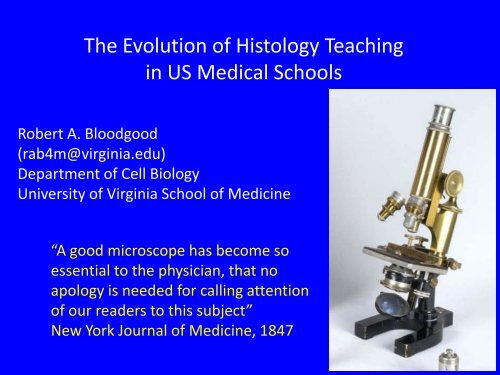The History of Medical Histology Teaching - American Association of ...
The History of Medical Histology Teaching - American Association of ...
The History of Medical Histology Teaching - American Association of ...
Create successful ePaper yourself
Turn your PDF publications into a flip-book with our unique Google optimized e-Paper software.
<strong>The</strong> Evolution <strong>of</strong> <strong>Histology</strong> <strong>Teaching</strong>in US <strong>Medical</strong> SchoolsRobert A. Bloodgood(rab4m@virginia.edu)Department <strong>of</strong> Cell BiologyUniversity <strong>of</strong> Virginia School <strong>of</strong> Medicine“A good microscope has become soessential to the physician, that noapology is needed for calling attention<strong>of</strong> our readers to this subject”New York Journal <strong>of</strong> Medicine, 1847
Joseph M. Leidy1 st president <strong>of</strong> the <strong>American</strong><strong>Association</strong> <strong>of</strong> Anatomists 1888-1891
Joseph Leidy (1823-1891)His biography by Leonard Warren is entitled:“<strong>The</strong> Last Man Who Knew Everything”He was a:Microscopist AnatomistPaleontologist AnthropologistProtozoologist Parasitologistand…much moreLeidy called the microscope“his first love” and was one <strong>of</strong> thefirst active microscopists in the US(from 1845)
Leidy as an early histologistImages <strong>of</strong> human liverLeidy as a Forensic ScientistLeidy is said to be the first personin America to utilize themicroscope for forensic purposes.In January, 1846, Joseph Leidy’scousin, Napoleon Leidy, asked himto examine evidence (blood onclothing and a hatchet) in a murdercase to see if it was chicken blood,as the suspect claimed. Caught in alie by Leidy’s research, the suspectconfessed.Joseph Leidy (1848) Researches into the ComparativeStructure <strong>of</strong> the Liver. <strong>American</strong> Journal <strong>of</strong> <strong>Medical</strong>Sciences 15:13-23.
What happened in the second half <strong>of</strong> the 19 th century (post Civil War)?• <strong>The</strong> beginnings <strong>of</strong> microphotography• Improved microtomes; improved stains• Advances in microscope design and the beginnings <strong>of</strong> US maderesearch microscopes and <strong>of</strong> low cost student microscopes (B&L)• Appearance <strong>of</strong> dedicated histology textbooks (some by US authors)• Rapid expansion <strong>of</strong> the number <strong>of</strong> US medical schools – the rise <strong>of</strong>the proprietary (for pr<strong>of</strong>it) medical schools• <strong>The</strong> concept <strong>of</strong> medical student laboratories beyond GrossAnatomy (inspired by the German medical school model)• Dedicated histology laboratory courses by the 1880s in selectmedical schools
text included actual lab experiments
Photography through the MicroscopeRichard Kerr taking a photomicrograph in 1904• 1 st photomicrographs probably taken with the solar microscope aroundthe 1830s• 1 st photomicrograph published in 1853• Use <strong>of</strong> lantern slides <strong>of</strong> photomicrographs in lectures in 1880s• Photomicrographs showing up in histology textbooks by 1917
Flexner Report 1910Abraham Flexner argued forthe scientific basis for medicaleducation"<strong>The</strong> country needs fewer and betterdoctors," Flexner argued, "and the way to getthe better is to produce fewer."Flexner’s plan for a uniformmedical curriculum:Two years <strong>of</strong> laboratory workTwo years <strong>of</strong> bedside/clinic work
Impact <strong>of</strong> the 1910 Flexner ReportIn 1911 there were 160 US <strong>Medical</strong> SchoolsIn 1920 there were 85 US <strong>Medical</strong> SchoolsLoss <strong>of</strong> the proprietary (for pr<strong>of</strong>it) medical schools that werenot aligned with an academic institution and did not invest inequipment and laboratory teaching.Routine laboratory instruction (including histology) atvirtually all remaining medical schools
To put a human face on histology teaching post-Flexner: 1918-1919Harvey JordanBruce Morton
University <strong>of</strong> Buffalo 1898
What happened after World War II?• Biological Electron Microscopy ~1954•Technology blossomed leading to digital cameras,microcomputers and the WWW 1980-90• Expansion <strong>of</strong> medical care as a role <strong>of</strong> academic medical centers• Expansion <strong>of</strong> the NIH and the flow <strong>of</strong> research money into medical schools• Changes in the reward system at medical schools
Competing Missions <strong>of</strong> <strong>Medical</strong> SchoolsLab <strong>Teaching</strong> HoursCase Western ReserveTuition fees as a percentage <strong>of</strong> total medical school income:1910 70%1948 28%1968 7%
National Trend in Hours <strong>of</strong> <strong>Histology</strong> Laboratory Instruction90807060504030201001967 1973 1978 1982 1995 2001 2005Hrs(Gartner, 2003; Bloodgood and Ogilvie, 2006; AAA Surveys)
Rise <strong>of</strong> the microcomputer and the WWW: Evolution <strong>of</strong> the Digital Microscopic Image1990: WWW opened to public; 1991: 1 st image archive <strong>of</strong> any kind on the WWWBasic ImagesLabeled ImagesNested images; mouse rollovers; soundsVirtual Slides
First volume published onVirtual Microscopy andVirtual Slides (2005)
Challenges/Opportunities Facing <strong>Histology</strong> <strong>Teaching</strong> Today and into the Future• Changes in the nature <strong>of</strong> the students entering medical school• Move towards integrated medical curriculaDr. Helen Amerongen• Emphasis on small groups and active learning• More physician involvement in the control <strong>of</strong> the pre-Clerkship curriculum• Reduction in scheduled time for basic science in the curriculum• <strong>The</strong> temptation to use computer technology to turn histology into a self-study exercise(freeing up space; money; faculty time)• competition for faculty time by the other missions <strong>of</strong> academic medical centers• the reward system in medical schools focuses on evaluation <strong>of</strong> faculty based ontheir income generating potential (clinical income or research grant income)• changes in the way that physicians practice medicine (will they be using microscopes?)Question: Are we at risk <strong>of</strong> losing the <strong>Medical</strong> Educator from the teaching <strong>of</strong> <strong>Histology</strong>?


